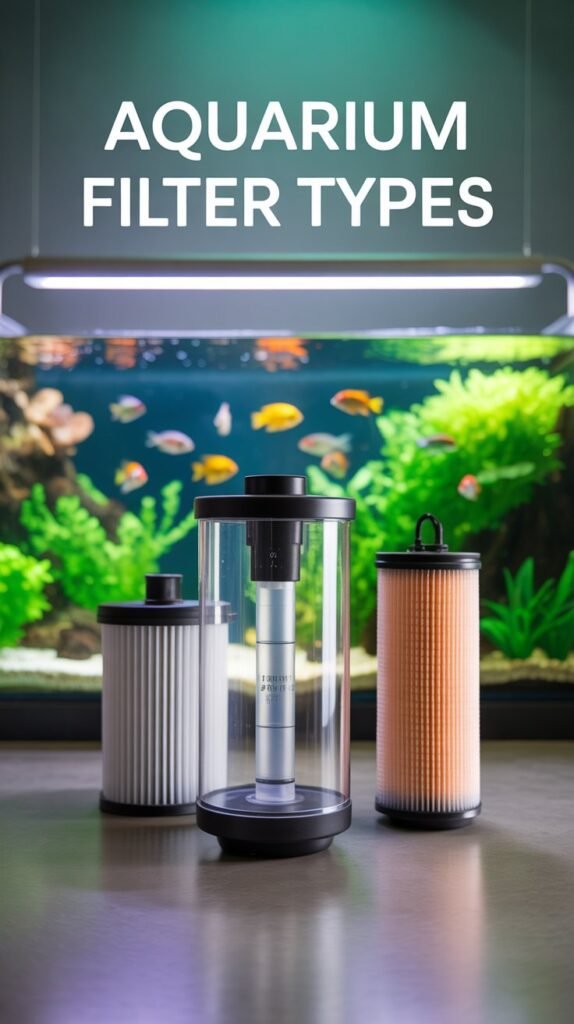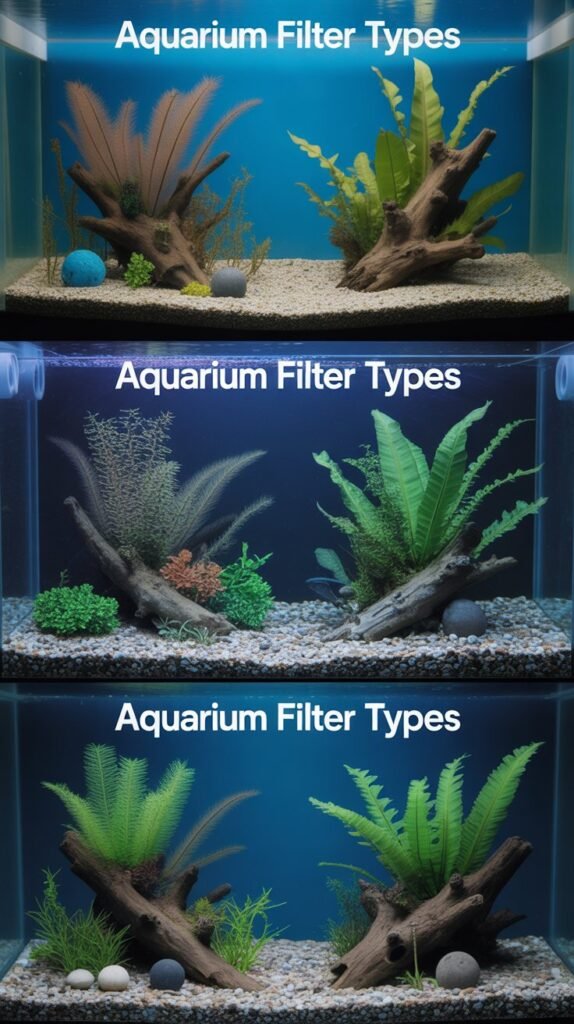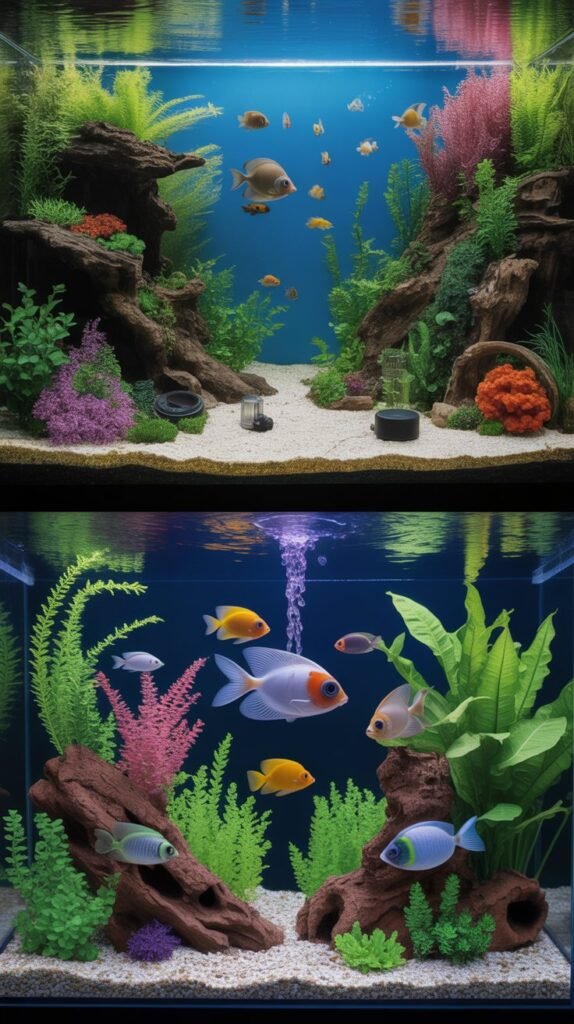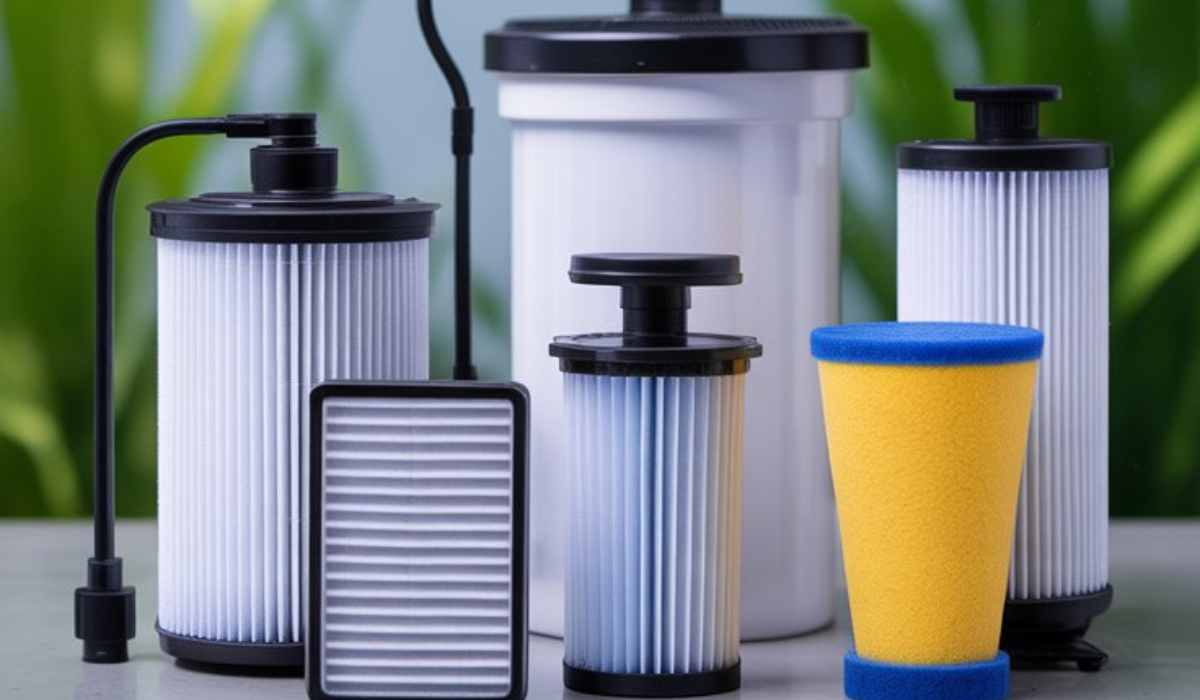Setting up a healthy and thriving aquarium requires much more than just adding water and fish. One of the most important components of any aquarium setup is filtration. Filters keep the water clean, remove toxins, and ensure your aquatic pets live in a stable, balanced environment. In this comprehensive guide, we’ll explore all aquarium filter types, their functions, pros and cons, and tips to choose the best one for your setup.
🐠 What Is an Aquarium Filter?
An aquarium filter is a device that removes waste, toxins, and debris from the tank water. It plays a vital role in maintaining water quality by processing biological, mechanical, and chemical filtration. Without a good filter, harmful substances like ammonia and nitrites can build up, making the water toxic for fish and plants.
A properly chosen filter not only keeps the aquarium clean but also helps stabilize oxygen levels, maintain clear water, and support beneficial bacteria growth.
🌿 The Three Types of Filtration

Before discussing the different aquarium filter types, it’s essential to understand the three kinds of filtration they perform:
1. Mechanical Filtration
Mechanical filtration physically removes particles and debris from the water, such as uneaten food, fish waste, and plant matter. Filters use sponges, pads, or floss to trap these particles, keeping the water visually clear.
2. Biological Filtration
This is the most critical type of filtration. It uses beneficial bacteria to break down harmful ammonia and nitrites into less toxic nitrates through the nitrogen cycle. This process keeps the water safe for fish and other aquatic creatures.
3. Chemical Filtration
Chemical filtration uses activated carbon or other chemical media to remove toxins, odors, discoloration, and impurities like chlorine. It helps polish the water and maintain a healthy, fresh environment.
⚙️ Major Aquarium Filter Types
There are several types of aquarium filters available, each designed for different tank sizes, setups, and levels of maintenance. Let’s explore the most popular ones:
1. Sponge Filter
Ideal for: Small tanks, breeding tanks, shrimp aquariums, and hospital tanks.
Sponge filters use air pumps to pull water through a sponge that traps debris and provides a large surface for beneficial bacteria to colonize.
Advantages:
- Gentle water flow — perfect for fry and small fish.
- Provides excellent biological filtration.
- Inexpensive and easy to clean.
- No risk of sucking in small fish or shrimp.
Disadvantages:
- Limited mechanical and chemical filtration.
- Not suitable for large or heavily stocked aquariums.
Best Use Tip: Pair it with a hang-on-back filter for better overall filtration in medium tanks.
2. Hang-On-Back (HOB) Filter
Ideal for: Small to medium aquariums (10–55 gallons).
Hang-on-back filters are popular for their convenience and efficiency. They hang on the back of the tank, drawing water up through an intake tube, filtering it, and then returning it via a waterfall effect.
Advantages:
- Provides mechanical, biological, and chemical filtration.
- Easy to maintain — filter media can be replaced easily.
- Aerates the water through the waterfall return.
Disadvantages:
- Can be noisy due to the waterfall.
- Limited capacity for large tanks.
Best Use Tip: Keep the intake tube clean and replace carbon cartridges monthly for optimal performance.
3. Internal Filter
Ideal for: Small aquariums or tanks without external space for a filter.
Internal filters are fully submerged in the aquarium and usually attached to the glass using suction cups. They provide mechanical and biological filtration through sponges and cartridges.
Advantages:
- Compact and quiet.
- Good for small tanks and simple setups.
- Easy to install and remove for cleaning.
Disadvantages:
- Takes up space inside the tank.
- Maintenance can disturb the fish.
Best Use Tip: Position it near the bottom for better debris collection and even water circulation.
4. Canister Filter
Ideal for: Medium to large aquariums (40 gallons and above).
Canister filters are powerful external filters that offer excellent multi-stage filtration. Water is drawn from the tank, processed through various filter media, and then pumped back in.
Advantages:
- Superior mechanical, biological, and chemical filtration.
- Customizable media — you can choose what to include.
- Very efficient and suitable for planted or heavily stocked tanks.
- Quiet operation once set up properly.
Disadvantages:
- Expensive compared to basic filters.
- Requires more effort to clean and maintain.
Best Use Tip: Clean the canister every 4–6 weeks to prevent clogging and maintain water flow.
5. Undergravel Filter

Ideal for: Freshwater aquariums with gravel substrate.
Undergravel filters work by pulling water through the substrate, using it as a biological and mechanical filter. Water is drawn down through the gravel and then returned through uplift tubes powered by an air pump or powerhead.
Advantages:
- Promotes excellent biological filtration.
- Hidden and quiet system.
- Affordable and simple design.
Disadvantages:
- Difficult to clean without disturbing the entire substrate.
- Inefficient in planted or sand-based tanks.
Best Use Tip: Combine it with a sponge pre-filter to prevent clogging and extend lifespan.
6. Fluidized Bed Filter
Ideal for: Large aquariums and high bioload setups.
This filter uses fine sand or other media that “fluidizes” as water passes through, creating a highly efficient biological filtration system.
Advantages:
- Extremely high biological filtration capacity.
- Compact and efficient design.
- Great for high-nutrient environments.
Disadvantages:
- No mechanical or chemical filtration.
- Needs a strong pump to operate properly.
Best Use Tip: Use it alongside a canister or HOB filter for complete filtration coverage.
7. Sump Filter
Ideal for: Marine, reef, or large freshwater aquariums.
A sump is a separate tank placed below the main aquarium. Water flows down into the sump, gets filtered through various chambers, and is then pumped back up.
Advantages:
- Large capacity for equipment (heaters, skimmers, etc.).
- Excellent for biological and chemical filtration.
- Keeps the main aquarium clutter-free.
- Can be customized with media, refugiums, and reactors.
Disadvantages:
- Requires plumbing and more setup effort.
- Can overflow if not properly managed.
Best Use Tip: Install a reliable overflow system and check water levels regularly to prevent flooding.
8. Trickle Filter (Wet/Dry Filter)
Ideal for: Saltwater or reef tanks.
Trickle filters expose water to air as it drips over bio-media, promoting maximum oxygenation and bacterial growth.
Advantages:
- Superb biological filtration.
- Keeps oxygen levels high.
- Reduces ammonia and nitrites efficiently.
Disadvantages:
- Can be noisy due to dripping water.
- Evaporation rates are higher.
Best Use Tip: Use bio-balls or ceramic rings for the best bacterial growth and performance.
🧪 Comparing Aquarium Filter Types
| Filter Type | Filtration Strength | Ideal Tank Size | Maintenance Level | Noise |
|---|---|---|---|---|
| Sponge Filter | Biological | Small | Low | Silent |
| HOB Filter | All-in-one | Small-Medium | Moderate | Medium |
| Internal Filter | Mechanical/Bio | Small | Low | Quiet |
| Canister Filter | All-in-one | Medium-Large | Moderate-High | Quiet |
| Undergravel Filter | Biological | Small-Medium | High | Silent |
| Sump Filter | All-in-one | Large | Moderate | Quiet |
| Trickle Filter | Biological | Large | Moderate | Medium |
💧 How to Choose the Right Aquarium Filter

Selecting the right filter depends on several key factors:
- Tank Size: Larger tanks need more powerful filters like canisters or sumps.
- Fish Stocking Level: More fish means more waste — choose a high-capacity filter.
- Type of Aquarium: Saltwater tanks need different filtration setups than freshwater.
- Budget: Filters range from affordable sponge filters to expensive sumps.
- Maintenance Preference: Choose a system that fits your maintenance routine.
Pro Tip: Aim for a filter that can process 4–6 times your tank’s volume per hour. For a 50-gallon tank, choose a filter with a flow rate of at least 200–300 gallons per hour (GPH).
🌊 Maintaining Your Aquarium Filter
Even the best filter needs regular maintenance to function properly. Here’s how to keep it in top shape:
- Rinse mechanical media (sponges, pads) in old tank water weekly.
- Replace activated carbon every 3–4 weeks.
- Never clean biological media with tap water — it kills beneficial bacteria.
- Inspect impellers, tubing, and seals for blockages or wear.
- Perform partial water changes regularly to complement filtration.
🐟 Common Mistakes to Avoid
- Over-cleaning the filter and removing beneficial bacteria.
- Using multiple chemical media that may strip essential nutrients.
- Ignoring flow rate and filter size requirements.
- Failing to prime or reassemble filters correctly after cleaning.
✅ Conclusion
A well-chosen and properly maintained aquarium filter is the backbone of a healthy aquatic ecosystem. From simple sponge filters to advanced sump systems, each filter type has its role depending on your aquarium’s size, inhabitants, and setup goals. Understanding how these filters work allows you to create a clean, balanced, and thriving underwater environment for your fish and plants.
❓FAQs About Aquarium Filter Types
Q1. What is the best type of aquarium filter for beginners?
A Hang-On-Back (HOB) filter is perfect for beginners because it’s easy to install, maintain, and provides complete filtration.
Q2. How often should I clean my aquarium filter?
Most filters should be cleaned every 2–4 weeks depending on tank size and fish load. Avoid cleaning all media at once to preserve beneficial bacteria.
Q3. Can I use two filters in one aquarium?
Yes, using multiple filters can improve water circulation and filtration efficiency, especially in large or heavily stocked tanks.
Q4. Do planted aquariums need filters?
Yes. While plants help absorb waste, filters are still necessary for mechanical and biological filtration to maintain stable water conditions.
Q5. How do I know if my filter is too strong for my fish?
If fish struggle to swim or are constantly pushed around, your filter’s flow rate might be too high. Use a flow control valve or baffle to reduce water movement.

